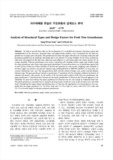

-
 * 본 문서는 배포용으로 복사 및 편집이 불가합니다.
* 본 문서는 배포용으로 복사 및 편집이 불가합니다.
미리보기
서지정보
· 발행기관 : 한국생물환경조절학회
· 수록지 정보 : 생물환경조절학회지(구 시설원예ㆍ식물공장) / 22권 / 1호
· 저자명 : 남상운, 고기혁
초록
본 연구는 과수재배 시설의 표준화 및 환경조절기술개발을 위한 기초자료로 제공하는 것을 목적으로 과수재배용 온실의 실태를 조사하여 구조유형과 설계요소를 분석하고, 기상재해에 대한 안전성과 구조 및 환경관리에 대한 개선방안을 검토하였다. 시설재배 면적이 가장 많은 5개 품목 중 주로 제주도에서 재배되고 있는 감귤과 현재 재배온실을 찾을 수 없는 단감을 제외한 포도, 배 및 복숭아재배 온실을 연구대상으로 하였다. 감귤과 포도재배 온실은 꾸준히 증가하고 있으나 저장시설의 발달로 배와 단감재배 온실은 감소하고 있는 추세이다. 앞으로는 비가림 효과가 크고 저장성이 떨어지는 품목을 중심으로 과수재배 온실의 변화가 예상된다. 조사대상 온실 중 배 재배 온실과 복숭아재배 대형 단동온실을 제외하고는 대체로 보급형 온실의 규격을 따르고 있으며, 재배작목별로 특성화된 온실은 없는 것으로 나타났다. 과수재배 온실의 대부분은 농촌진흥청과 농림수산식품부에서 고시한 농가보급형 모델이나 내재해형 모델의 부재규격을 따르고 있었다. 기초는 대부분 콘크리트 기초를 사용하고 있었으며, 배 재배 온실의 경우에는 내재해형 모델보다 두꺼운 단면의 기둥을 사용하고, 강판을 기둥의 하단에 용접하여 매설한 형태의 특수한 기초를 적용하고 있었다. 조사대상 온실의 구조적 안전성을 검토한 결과 대부분 안전하였으나 김천과 천안의 포도재배 온실, 남원과 천안의 복숭아재배 온실에서 적설에 불안전한 것으로 나타났고, 남원의 복숭아재배 온실은 풍속에 대한 안전성도 부족한 것으로 나타났다. 또한 채소재배 온실을 복숭아재배로 전용한 온실의 경우 적설과 풍하중 모두 상당히 불안정한 것으로 나타났다. 과수의 수형, 수고 및 재식간격을 고려하여 과수 재배 온실의 적정규격을 검토한 결과 포도재배 온실은 폭 7.0~8.0m, 측고 2.5~2.8m가 적당하고, 배와 복숭아재배 온실은 폭 6.0~7.0m, 측고 3.0~3.3m 정도가 적당한 것으로 판단된다.영어초록
In order to provide basic data for the development of a controlled environment cultivation system and standardization of the structures, structural status and improvement methods were investigated for the fruit tree greenhouses of grape, pear, and peach. The greenhouses for citrus and grape cultivation are increasing while pear and persimmon greenhouses are gradually decreasing due to the advance of storage facilities. In the future, greenhouse cultivation will expand for the fruit trees which are more effective in cultivation under rain shelter and are low in storage capability. Fruit tree greenhouses were mostly complying with standards of farm supply type models except for a pear greenhouse and a large single-span peach greenhouse. It showed that there was no greenhouse specialized in each species of fruit tree. Frame members of the fruit tree greenhouses were mostly complying with standards of the farm supply type model or the disaster tolerance type model published by MIFAFF and RDA. In most cases, the concrete foundations were used. The pear greenhouse built with the column of larger cross section than the disaster tolerance type. The pear greenhouse had also a special type of foundation with the steel plate welded at the bottom of columns and buried in the ground. As the results of the structural safety analysis of the fruit tree greenhouses, the grape greenhouses in Gimcheon and Cheonan and the peach greenhouses in Namwon and Cheonan appeared to be vulnerable for snow load whereas the peach greenhouse in Namwon was not safe enough to withstand wind load. The peach greenhouse converted from a vegetable growing facility turned out to be unsafe for both snow and wind loads. Considering the shape, height and planting space of fruit tree, the appropriate size of greenhouses was suggested that the grape greenhouse be 7.0~8.0 m wide and 2.5~2.8 m high for eaves, while 6.0~7.0 m wide and 3.0~3.3 m of eaves height for the pear and peach greenhouses.참고자료
· 없음태그
-
자료후기
-
자주묻는질문의 답변을 확인해 주세요

꼭 알아주세요
-
본 학술논문은 (주)코리아스칼라와 각 학회간에 저작권계약이 체결된 것으로 AgentSoft가 제공 하고 있습니다.
본 저작물을 불법적으로 이용시는 법적인 제재가 가해질 수 있습니다. -
해피캠퍼스는 구매자와 판매자 모두가 만족하는 서비스가 되도록 노력하고 있으며, 아래의 4가지 자료환불 조건을 꼭 확인해주시기 바랍니다.
파일오류 중복자료 저작권 없음 설명과 실제 내용 불일치 파일의 다운로드가 제대로 되지 않거나 파일형식에 맞는 프로그램으로 정상 작동하지 않는 경우 다른 자료와 70% 이상 내용이 일치하는 경우 (중복임을 확인할 수 있는 근거 필요함) 인터넷의 다른 사이트, 연구기관, 학교, 서적 등의 자료를 도용한 경우 자료의 설명과 실제 자료의 내용이 일치하지 않는 경우
“생물환경조절학회지(구 시설원예ㆍ식물공장)”의 다른 논문도 확인해 보세요!
-
동절기 온실의 열 손실에 관한 실태조사 - 경남지역을 중심으로 - 7 페이지
본 연구에서는 온실의 열손실을 최소화할 방안을 모색하기 위하여 경남지역에 있는 시설 농가를 대상으로 열화상 카메라를 이용하여 열손실 사례에 대한 실태조사를 실시하였다. 그 결과를 요약하면 다음과 같다. 치마처리 전 후의 두 실험구간의 온도차는 각각 2.0~3.0℃ 및 1.0~2.0℃ 정도인 것을 알 수 있다. 열화상 기기에 의해 계측된 온도와 온도 센서에 .. -
원수의 중탄산 농도가 근권 화학성 변화 및 상추의 생장에 미치는 영향 8 페이지
관개수의 중탄산 농도가 상추의 생장 및 근권 환경 변화에 미치는 영향을 구명하기 위해 본 연구를 수행하였다. 펄라이트를 직경 10cm의 플라스틱 화분에 충전하고 청축면 및 적축면 상추를 정식하였다. 중성비료를 이용하여 질소기준 100mg·L-1로 농도를 조절하여 시비하였고, 관비용액에 중탄산(HCO3-) 농도를 30, 70, 110, 150, 및 180mg.. -
볶음 오크라 종자의 주요 기능성분 분석 4 페이지
본 연구는 오크라 종자를 볶았을 때의 기능성을 성분을 분석하여 용도 다양화를 위한 볶음차로의 이용 가능성을 검토하기 위하여 수행하였다. 꼬투리 당 오크라 종자의 수는 '그린소드' 품종이 78개, '베니' 품종이 88개 이었고, 과실 당 종자무게는 각각 4.4g과 6.3g이었다. 볶은 오크라 종자의 유리아미노산 함량은 2.69mg·g-1으로 생체종자의 0.3.. -
레몬 하우스 재배에 있어 시기별 과즙의 Hesperidin 함량변화에 따른 적정수확 기준 5 페이지
본 연구는 레몬과즙의 헤스페리딘 함량이 가장 많은 수확시기 지표를 결정하기 위해 수관내부 및 외부에 착과된 과실에 대해 시기별 헤스페리딘 함량을 착색시기 및 과중과 연관시켜 평가했다. 그 함량은 과실생장에 따라 달랐으며 수관내부 및 외부에 있어 착색이 막 시작되는 개화 후 162일과 176일째에 가장 많았다. 그리고 수관외부가 내부보다 많았다. 이상의 결과.. -
LED광 파장이 국화생육에 미치는 영향 6 페이지
국화생육에 있어서 LED광이 미치는 영향을 구명하기 위해서 국화 'Shinma'를 대상으로 단일광 적색광(Red) 650nm, 647nm, 622nm, 청색광(Blue) 463nm, 450nm, 백색광(White)과 혼합광(적색광(Red) :청색광(Blue)-(9 : 1, 8 : 2, 7 : 3, 6 : 4, 5 : 5), 적색광(Red) :백색광(Whit..
문서 초안을 생성해주는 EasyAI


